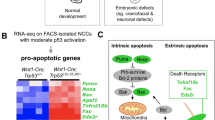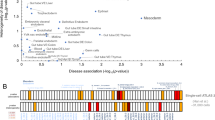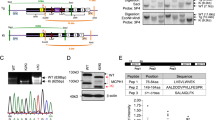Abstract
Defects in neural tube formation are among the most common malformations leading to infant mortality. Although numerous genetic loci appear to contribute to the defects observed in humans and in animal model systems, few of the genes involved have been characterized at the molecular level. Mice lacking the p53 tumour suppressor gene are predisposed to tumours, but the viability of these animals indicates that p53 function is not essential for embryonic development. Here, we demonstrate that a fraction of p53–deficient embryos in fact do not develop normally. These animals display defects in neural tube closure resulting in an overgrowth of neural tissue in the region of the mid–brain, a condition known as exencephaly.
This is a preview of subscription content, access via your institution
Access options
Subscribe to this journal
Receive 12 print issues and online access
$209.00 per year
only $17.42 per issue
Buy this article
- Purchase on SpringerLink
- Instant access to full article PDF
Prices may be subject to local taxes which are calculated during checkout
Similar content being viewed by others
References
Harris, C.C. & Hollstein, M. Clinical implications of the p53 tumour-suppressor gene. New Engl. J. Med. 329, 1318–1327 (1993).
Kastan, M.B., Onyekwere, O., Sidransky, D., Vogelstein, B. & Craig, R.W. Participation of p53 protein in the cellular response to DMA damage. Cancer Res. 51, 6304–6311 (1991).
Kastan, M. et al. A mammalian cell cycle checkpoint pathway utilizing p53 and GADD45 is defective in ataxia-telangiectasia. Cell 71, 587–597 (1992).
Lowe, S.W., Schmitt, E.S., Smith, S.W., Osborne, B.A. & Jacks, T. p53 is required for radiation-induced apoptosis in mouse thymocytes. Nature 362, 847–849 (1993).
Lowe, S.W., Ruley, H.E., Jacks, T. & Housman, D.E., Housman, D.E. p53-dependent apoptosis modulates the cytoxicity of anticancer agents. Cell 74, 957–967 (1993).
Clarke, A.R. et al. Thymocyte apoptosis induced by p53-dependent and independent pathways. Nature 362, 849–852 (1993).
Lowe, S.W., Jacks, T., Housman, D.E. & Ruley, H.E. Abrogation of oncogene-associated apoptosis allows transformation of p53-deficient cells. Proc. natn. Acad. Sci. U.S.A. 91, 2026–2030 (1994).
Shaw, P. et al. Induction of apoptosis by wild-type p53 in a human colon tumour-derived cell line. Proc. natn. Acad. Sci. U.S.A. 89, 4495–4499 (1992).
Yonish-Rouach, E. et al. Wild-type p53 induces apoptosis of myeloid leukaemic cells that is inhibited by interleukin-6. Nature 352, 345–347 (1991).
Debbas, M. & White, E. Wild-type p53 mediates apoptosis by E1A, which is inhibited by E1B. Genes and Dev. 7, 546–554 (1993).
Symonds, H. et al. p53-dependent apoptosis suppresses tumour growth and progression In vivo. Cell 78, 703–711 (1994).
Donehower, L.A. et al. Mice deficient for p53 are developmentally normal but susceptible to spontaneous tumours. Nature 356, 215–221 (1992).
Jacks, T. et al. Tumour spectrum analysis in p53-mutant mice. Curr. Biol. 4, 1–7 (1994).
Purdie, C.A. et al. Tumour incidence, spectrum and ploidy in mice with a large deletion in the p53 gene. Oncogene 9, 603–609 (1994).
Tsukada, T. et al. Enhanced proliferative potential in culture of cells from p53-deficient mice. Oncogene 8, 3313–3322 (1993).
Neumann, P.E. et al. Multifactorial inheritance of neural tube defects: localization of the major gene and recognition of modifiers in ct mutant mice. Nature Genet. 6, 357–362 (1994).
Copp, A.J., Brook, F.A., Estibeiro, J.P., Shum, A.S.W. & Cockroft, D.L. The embryonic development of mammalian neural tube defects. Prog. Neurobiology 35, 363–403 (1990).
Campbell, L.R., Datton, D.H. and Sohal, G.S. Neural tube defects: a review of human and animal studies on the etiology of neural tube defects. Teratology 34, 171–187 (1986).
Gruneberg, H. Genetical studies on the skeleton of the mouse VII. Curly tail. J. Genet. 52, 52–67 (1954).
Copp, A.J., Brook, F.A. & Roberts, H.J. A cell-type-specific abnormality of cell proliferation in mutant (curly tail) mouse embryos developing spinal neural tube defects. Development 104, 285–295 (1988).
Jacks, T. et al. Effects of an Rb mutation in the mouse. Nature 359, 295–300 (1992).
Jacks, T. et al. Tumourigenic and developmental consequences of a targeted Nf1 mutation in the mouse. Nature Genet. 7, 353–361 (1994).
Page, D.C. et al. The sex-determining region of the human Y chromosome encodes a finger protein. Cell 51, 1091–1104 (1987).
McKay, I.J. et al. The kreisler mouse: a hindbrain segmentation mutant that lacks two rhombomeres. Development 120, 2199–2211 (1994).
Rotter, V. et al. Mice with reduced levels of p53 protein exhibit the testicular giant-cell degenerative syndrome. Proc. natn. Acad. Sci. U.S.A. 90, 9075–9079 (1993).
Rogel, A., Popliker, M., Webb, C.G. & Oren, M. p53 cellular tumour antigen: analysis of mRNA levels in normal adult tissues, embryos, and tumours. Molec. cell. Biol. 5, 2851–2855 (1985).
Schmid, P., Lorenz, A., Hameister, H. & Montenarh, M. Expression of p53 during mouse embryogenesis. Development 113, 857–865 (1991).
Lee, E.Y. Y.-H.P.et al. Mice deficient for Rb are nonviable and show defects in neurogenesis and haematopoiesis. Nature 359, 288–295 (1992).
Clarke, A.R. et al. Requirement for a functional Rb-1 gene in murine development. Nature 359, 328–330 (1992).
Kreidberg, J.A. et al. WT-1 is required for early kidney development. Cell 74, 679–691 (1993).
Brannan, C.I. et al. Targeted disruption of the neurofibromatosis type-1 gene leads to developmental abnormalities in heart and various neural crest-derived tissues. Genes Dev. 8, 1019–1029 (1994).
Copp, A.J. Neural tube defects. Trends Neurosci. 16, 381–383 (1993).
Macdonald, K.B., Juriloff, D.M. & Harris, M.J. Developmental study of neural tube closure in a mouse stock with a high incidence of exencephaly. Teratology 39, 195–213 (1989).
Oliner, J.D. Discerning the function of p53 by examining its molecular interactions. BioEssays 15, 703–707 (1993).
Macleod, K. et al. p53-Dependent and independent expression of p21 during cell growth, differentiation and DNA-damage. Genes Dev. (in the press).
Epstein, D.J., Vekemans, M. & Gros, P. Splotch (Sp2H), a mutation affecting development of the mouse neural tube, shows a deletion within the paired homoedomain of Pax-3. Cell 67, 767–774 (1991).
Hui, C. & Joyner, A.L. A mouse model of Greig cephalopolysyndactyly: the extra-toes mutation contains an intragenic deletion of the Gli3 gene. Nature Genet. 3, 241–246 (1993).
Gavrieli, Y., Sherman, Y. & Ben-Sasson, S.A. Identification of programmed cell death in situ via specific labeling of nuclear DNA fragmentation. J. cell. Biol. 119, 493–501 (1992).
Author information
Authors and Affiliations
Rights and permissions
About this article
Cite this article
Sah, V., Attardi, L., Mulligan, G. et al. A subset of p53-deficient embryos exhibit exencephaly. Nat Genet 10, 175–180 (1995). https://doi.org/10.1038/ng0695-175
Received:
Accepted:
Issue Date:
DOI: https://doi.org/10.1038/ng0695-175



